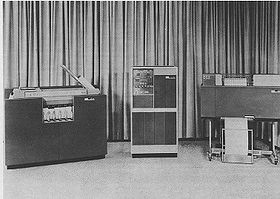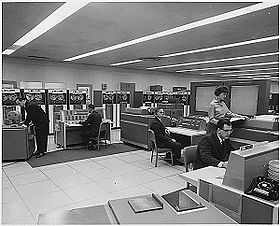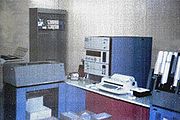
Punched card reader
Encyclopedia




The earliest computers, such as ENIAC
ENIAC
ENIAC was the first general-purpose electronic computer. It was a Turing-complete digital computer capable of being reprogrammed to solve a full range of computing problems....
were programmed and fed data using switches, patch cords and punched paper tape or film
Punched tape
Punched tape or paper tape is an obsolete form of data storage, consisting of a long strip of paper in which holes are punched to store data...
. When IBM
IBM
International Business Machines Corporation or IBM is an American multinational technology and consulting corporation headquartered in Armonk, New York, United States. IBM manufactures and sells computer hardware and software, and it offers infrastructure, hosting and consulting services in areas...
entered and began to dominate the computer industry starting in the early 1950s, it used the punched card
Punched card
A punched card, punch card, IBM card, or Hollerith card is a piece of stiff paper that contains digital information represented by the presence or absence of holes in predefined positions...
for programming, data input and often for data output. IBM had been selling punched card based unit record equipment
Unit record equipment
Before the advent of electronic computers, data processing was performed using electromechanical devices called unit record equipment, electric accounting machines or tabulating machines. Unit record machines were as ubiquitous in industry and government in the first half of the twentieth century...
for over half a century by then and its technology was mature and reliable. Business were familiar with storing data on punched cards and keypunch machines and their operators were widely employed. Punched cards were a good fit with the new art of computer programming, as having individual machine instructions or programming language statements entered on separate punched cards allowed programs to be edited relatively easily. See computer programming in the punched card era.
IBM adapted electromechanical card reading and punching mechanisms for use on early computing experiments, such as the IBM Selective Sequence Electronic Calculator and the IBM Card Programmed Calculator
IBM CPC
The IBM Card-Programmed Electronic Calculator or CPC was announced by IBM in May 1949. Later that year an improved machine, the CPC-II was also announced.The original CPC Calculator had the following machines interconnected by cables:...
and used them on its electronic computers starting with the IBM 701
IBM 701
The IBM 701, known as the Defense Calculator while in development, was announced to the public on April 29, 1952, and was IBM’s first commercial scientific computer...
. Card readers and and punches were ubiquitous on computers supplied by IBM, and most of its competitors, through the mid-1970s.
Documation
Documation Inc., of Melbourne, Florida, made card readers for minicomputers in the 1970s:- M-200 card reader, 300 cards/minutealso sold by DEC as the CR-11 card reader for the PDP-11PDP-11The PDP-11 was a series of 16-bit minicomputers sold by Digital Equipment Corporation from 1970 into the 1990s, one of a succession of products in the PDP series. The PDP-11 replaced the PDP-8 in many real-time applications, although both product lines lived in parallel for more than 10 years...
- M-1000-L card reader 1000 cards/minute
IBM
- IBM 322 — IBM 305IBM 305The IBM 305 RAMAC, publicly announced on September 13, 1956, was the first commercial computer that used a moving head hard disk drive for secondary storage. RAMAC stood for "Random Access Method of Accounting and Control". Its design was motivated by the need for real-time accounting in business...
card reader - IBM 533IBM 533The IBM 533 Input-Output Unit, announced on July 2, 1953, was a punched card reader and punch that served as the primary input-output unit for the IBM 650 computer. It had two independent card paths, one for reading and one for punching. IBM cards were fed face down, 12-edge first...
— IBM 650IBM 650The IBM 650 was one of IBM’s early computers, and the world’s first mass-produced computer. It was announced in 1953, and over 2000 systems were produced between the first shipment in 1954 and its final manufacture in 1962...
card read punch - IBM 537 — IBM 650IBM 650The IBM 650 was one of IBM’s early computers, and the world’s first mass-produced computer. It was announced in 1953, and over 2000 systems were produced between the first shipment in 1954 and its final manufacture in 1962...
card read punch - IBM 543 — IBM 650IBM 650The IBM 650 was one of IBM’s early computers, and the world’s first mass-produced computer. It was announced in 1953, and over 2000 systems were produced between the first shipment in 1954 and its final manufacture in 1962...
card reader - IBM 711 — IBM 700 series card reader
- IBM 712 — IBM 700 series card reader
- IBM 714 — IBM 700 series card reader
- IBM 1402IBM 1402The IBM 1402 was a high speed card reader/punch introduced on October 5, 1959 as a peripheral input/output device for the IBM 1401 computer. It was later used with other computers of the IBM 1400 series and IBM 7000 series product lines...
— IBM 1401IBM 1401The IBM 1401 was a variable wordlength decimal computer that was announced by IBM on October 5, 1959. The first member of the highly successful IBM 1400 series, it was aimed at replacing electromechanical unit record equipment for processing data stored on punched cards...
card reader/punch - IBM 1412 — IBM 1440IBM 1440The IBM 1440, a member of the IBM 1400 series, was an IBM computer designed as a low-cost system for smaller businesses. It was announced on October 11, 1962 and withdrawn on February 8, 1971....
card reader/punch - IBM 1442IBM 1442IBM 1442 was a combination IBM card reader and card punch. It read and punched 80-column IBM-format punched cards and was used on the IBM 1440, the IBM 1130, the IBM 1800 and System/360 and was an option on the IBM System/3. The 1442 could read up to 400 cards per minute. Cards were read and...
— IBM 1440IBM 1440The IBM 1440, a member of the IBM 1400 series, was an IBM computer designed as a low-cost system for smaller businesses. It was announced on October 11, 1962 and withdrawn on February 8, 1971....
, IBM 1130IBM 1130The IBM 1130 Computing System was introduced in 1965. It was IBM's least-expensive computer to date, and was aimed at price-sensitive, computing-intensive technical markets like education and engineering. It succeeded the IBM 1620 in that market segment. The IBM 1800 was a process control variant...
and IBM System/360 card reader/punch - IBM 1622 — IBM 1620IBM 1620The IBM 1620 was announced by IBM on October 21, 1959, and marketed as an inexpensive "scientific computer". After a total production of about two thousand machines, it was withdrawn on November 19, 1970...
series card reader/punch - IBM 1444 — IBM 1400 series card reader/punch
- IBM 2501 — IBM System/360 card reader (up to 1,200 cpm)
- IBM 2540 — IBM System/360 card reader/punch
- IBM 2560 — Multifunction card machine (reader/punch/interpreter/multi-hopper)
- IBM 3505 — IBM System/370 card readerhttp://www.computerhistory.org/collections/accession/X1640.99A
- IBM 5424 — MFCU Multi Function card Unit (reader/punch/printer/multi-hopper)- 96 column, System/3
- IBM 7500 — IBM 7070IBM 7070IBM 7070 was a decimal architecture intermediate data processing system that was introduced by IBM in June 1960. It was part of the IBM 700/7000 series, and was based on discrete transistors rather than the vacuum tubes of the 1950s. It was the company's first transistorized stored-program...
series card reader - IBM 7501 Console Card Reader, based on a IBM 026 keypunch
- IBM 7503 — IBM 7070IBM 7070IBM 7070 was a decimal architecture intermediate data processing system that was introduced by IBM in June 1960. It was part of the IBM 700/7000 series, and was based on discrete transistors rather than the vacuum tubes of the 1950s. It was the company's first transistorized stored-program...
series card reader
IBM
- IBM 323 — IBM 305IBM 305The IBM 305 RAMAC, publicly announced on September 13, 1956, was the first commercial computer that used a moving head hard disk drive for secondary storage. RAMAC stood for "Random Access Method of Accounting and Control". Its design was motivated by the need for real-time accounting in business...
card punch - IBM 533IBM 533The IBM 533 Input-Output Unit, announced on July 2, 1953, was a punched card reader and punch that served as the primary input-output unit for the IBM 650 computer. It had two independent card paths, one for reading and one for punching. IBM cards were fed face down, 12-edge first...
— IBM 650IBM 650The IBM 650 was one of IBM’s early computers, and the world’s first mass-produced computer. It was announced in 1953, and over 2000 systems were produced between the first shipment in 1954 and its final manufacture in 1962...
card read punch - IBM 537 — IBM 650IBM 650The IBM 650 was one of IBM’s early computers, and the world’s first mass-produced computer. It was announced in 1953, and over 2000 systems were produced between the first shipment in 1954 and its final manufacture in 1962...
card read punch - IBM 544 — IBM 650IBM 650The IBM 650 was one of IBM’s early computers, and the world’s first mass-produced computer. It was announced in 1953, and over 2000 systems were produced between the first shipment in 1954 and its final manufacture in 1962...
card punch - IBM 721 — IBM 700 series card punch
- IBM 722 — IBM 700 series card punch
- IBM 1402IBM 1402The IBM 1402 was a high speed card reader/punch introduced on October 5, 1959 as a peripheral input/output device for the IBM 1401 computer. It was later used with other computers of the IBM 1400 series and IBM 7000 series product lines...
— IBM 1401IBM 1401The IBM 1401 was a variable wordlength decimal computer that was announced by IBM on October 5, 1959. The first member of the highly successful IBM 1400 series, it was aimed at replacing electromechanical unit record equipment for processing data stored on punched cards...
card reader/punch - IBM 1412 — IBM 1440IBM 1440The IBM 1440, a member of the IBM 1400 series, was an IBM computer designed as a low-cost system for smaller businesses. It was announced on October 11, 1962 and withdrawn on February 8, 1971....
card reader/punch - IBM 1442IBM 1442IBM 1442 was a combination IBM card reader and card punch. It read and punched 80-column IBM-format punched cards and was used on the IBM 1440, the IBM 1130, the IBM 1800 and System/360 and was an option on the IBM System/3. The 1442 could read up to 400 cards per minute. Cards were read and...
— IBM 1440IBM 1440The IBM 1440, a member of the IBM 1400 series, was an IBM computer designed as a low-cost system for smaller businesses. It was announced on October 11, 1962 and withdrawn on February 8, 1971....
, IBM 1130IBM 1130The IBM 1130 Computing System was introduced in 1965. It was IBM's least-expensive computer to date, and was aimed at price-sensitive, computing-intensive technical markets like education and engineering. It succeeded the IBM 1620 in that market segment. The IBM 1800 was a process control variant...
and IBM System/360 card reader/punch - IBM 1444 — IBM 1400 series card reader/punch
- IBM 1500IBM 1500The IBM 1500 instructional system was introduced by IBM on March 31, 1966 and its primary purpose was to implement Computer Assisted Instruction . Based around either an IBM 1130 or an IBM 1800 computer, it supported up to 32 student work stations each with a variety of audiovisual...
— IBM 1500IBM 1500The IBM 1500 instructional system was introduced by IBM on March 31, 1966 and its primary purpose was to implement Computer Assisted Instruction . Based around either an IBM 1130 or an IBM 1800 computer, it supported up to 32 student work stations each with a variety of audiovisual...
series card reader/punch - IBM 1622 — IBM 1620IBM 1620The IBM 1620 was announced by IBM on October 21, 1959, and marketed as an inexpensive "scientific computer". After a total production of about two thousand machines, it was withdrawn on November 19, 1970...
series card reader/punch - IBM 2540 — IBM System/360 card reader/punch
- IBM 2560 — Multifunction card machine (reader/punch/interpreter/multi-hopper)
- IBM 3525 — IBM System/370 card punch http://www.computerhistory.org/collections/accession/X1640.99B
- IBM 5424 — MFCU Multi Function card Unit (reader/punch/printer/multi-hopper)- 96 column, System/3
- IBM 7500 — IBM 7070IBM 7070IBM 7070 was a decimal architecture intermediate data processing system that was introduced by IBM in June 1960. It was part of the IBM 700/7000 series, and was based on discrete transistors rather than the vacuum tubes of the 1950s. It was the company's first transistorized stored-program...
card punch
See also
- Punched cards
- Card punch
- Keypunch
- Unit record equipmentUnit record equipmentBefore the advent of electronic computers, data processing was performed using electromechanical devices called unit record equipment, electric accounting machines or tabulating machines. Unit record machines were as ubiquitous in industry and government in the first half of the twentieth century...

